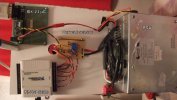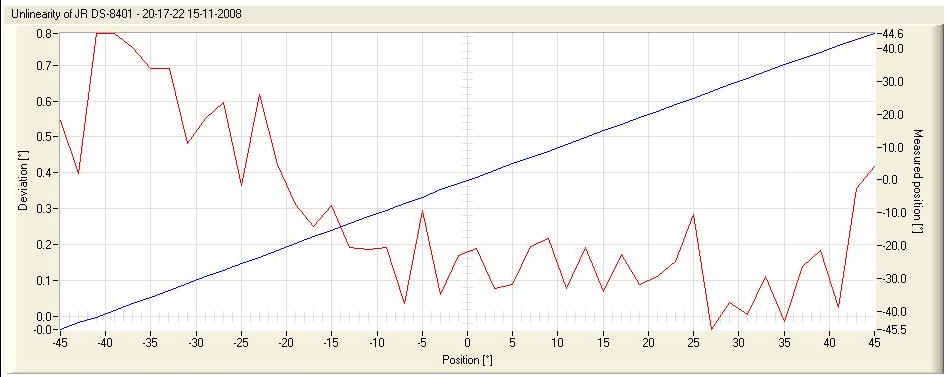|













| |
Servo testing
As part of the continuous task of keeping up and perhaps
improving my level of competitiveness in F3A I have started to look seriously
into the servos. I find it very hard to do meaningful comparisons of the
spec's that the manufacturers supply us with. Not that I have problems to read
the numbers, but more if these figures are worth comparing at all. As I am
an engineer working with testing of sensor-devices, I know that it is more or
less meaningless to compare figures if the test-methods are not the same.
And I am 100% sure that the manufacturers selects test-methods that yields the
best possible numbers for their own products.
Many years ago I used my EagleTree logger with a servo-current
sensor attached to one servo at a time, to try to determine what kind of loads
the servos do see during a typical F3A flight schedule. The next step was to perform measurements on the servo's to understand what load the servos
are exposed to during a flight. I suspect that stories of blow-back of
rudder servos during KE maneuvers and similar is exaggerated at the best.
To be able to test servos with a comparable result, I have then created the rig
as described below.
The test-rig contains some major components :
-
A PC-controlled servo-pulse generator
-
A precision potentiometer used to measure servo output
angle.
-
A robust power to supply voltage to servo (PC PSU 5V
12A, 12 4A).
-
A current-to-voltage sensor (to enable servo-current
measurement), LEM LTS 6-NP.
-
Pulleys, wires and weights to generate torque, I have made
weights to generate torque in steps of 0.5[kg-cm].
-
A PC-connected data acquisition device (NI USB-6009) to
measure current, voltage and position.
 Bottom
side of the test-rig shows the BX-24 µC, the NI USB-6009, the current sensor
and the PSU Bottom
side of the test-rig shows the BX-24 µC, the NI USB-6009, the current sensor
and the PSU
 Top-side
with a servo mounted with pulley and weights attached to generate 1.5[kg-cm] of
torque. Top-side
with a servo mounted with pulley and weights attached to generate 1.5[kg-cm] of
torque.
 Top-side
again showing the connection between servo and reference potentiometer, pulley
and torqe generating weights. Top-side
again showing the connection between servo and reference potentiometer, pulley
and torqe generating weights.
So, what can be measure by using this rig ? To take it one
by one I have typically been doing these tests :
-
Deflection and current consumption at static load : Simply measure the
current consumption while the servo is stationary. Apply different
static torques, and measure the current, and how far off from center that
the servo is moved. A side result from these kind of readings, are the
internal update frequency of the servo. Modern 'digital' servos update the
output (and draws current) at a much faster rate than it receives
position-signals from the receiver. Old 'analogue' servos updates the
output each time a signal is received.
-
Sensitivity : How many degrees does the servo move per 1[ms]
change in the input-signal pulse-length. A positive value means that the
servo when seen from above rotates clockwise with an increasing
pulse-length.
-
Deviation/linearity : This test moves the servo in steps of 2.5[°]
and measures the position for each step. The difference in actual position
compared to target position is measured an calculated. The peak
difference value is extracted, together with a graph showing the response.
-
Accuracy : In this test the servo is moved slowly towards
center, from both directions. The difference in end-position when
moving from each direction is presented. This test is performed with
different loads.
-
Sweep-speed : The servo is moved off to one side, then is moved as
fast as possible to the other side. During movement the position,
current consumption and also the supplied voltage is measured. Post
processing finds when the servo is 30° before and after center and thus
calculates the time it takes for the servo to move over 60°. In the
time period between -30° and +30° the current consumption is averaged and
presented together with peak value of the current consumption in the whole
measurement sequence. The speed are measured with different loads. One
graph showing the whole movement and current consumption is presented.
Start-stop speed : The speed when moving without load from
start at -X° to stop at +X°, this includes the time needed for starting and
stopping the movement.
A typical test-result presentation contains these elements :

The
general description contains references to the tested device, test-conditions,
and also some general results.

Current consumption when servo is stationary is presented like this, one
column with the applied torque, one with the average consumption and one that
shows the angle deviation generated by the applied torque.

Accuracy when moving towards center, one column with the applied torque and
one with the deviation angle between the two end-positions.

During speed measurements a lot of data is acquired, first column contains
the applied torque, the next the measured speed, then the average current
consumption when moving from-30 to +30°, and finally the peak current.
The position deviation (linearity) is also presented as a graph as shown
below. The blue line shows the target positions, while the red one shows the
servo's deviation from the target.

Also the last speed measurement is presented, blue line shows the servo
position and the magenta the current consumption. It is worth-while to
make a note that the peak-current used to start the movement is far higher than
the average current, and the peak value is close to independent of the
servo-load. The Current as presented below is slightly filtered to get a
smooth curve, unfiltered the system is capable of measuring each current pulse
that the servo's are sinking. The last picture below show the same type of
result as this one, but with unfiltered current.


|
![]() Ola
Fremming's homepage
Ola
Fremming's homepage